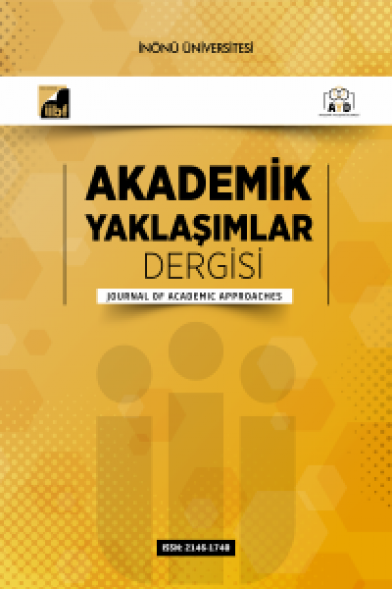FROM ARMED CONFLICT TO POLITICAL CONFLICT: TERRORIST ORGANIZATIONS TRANSFORMED TO POLITICAL PARTIES
Çatışma, Terör Örgütü, Barış Süreci, Siyasi Parti, Siyasi Katılım, Conflict, Terrorist Organization, Peace Process, Political Party, Political Participation
FROM ARMED CONFLICT TO POLITICAL CONFLICT: TERRORIST ORGANIZATIONS TRANSFORMED TO POLITICAL PARTIES
Conflict, Terrorist Organization, Peace Process, Political Party, Political Participation,
___
- Alonso, R. (2016). Terrorist skin, peace-party mask: the political communication strategy of Sinn Féin and the PIRA. Terrorism and Political Violence, 28(3), 520-540.
- Álvarez, A. M. (2011). De guerrilla a partido político: El Frente Farabundo Martí para la Liberación Nacional (FMLN). Historia y Política, 25(1), 207-233.
- BBC News (2016). Colombia Referendum: Voters Reject Farc Peace Deal. October 3, 2016, https://www.bbc.com/news/world-latin-america-37537252.
- Bew, J. (2011). The lessons of Northern Ireland: Collective amnesia and the Northern Ireland model of conflict resolution. IDEAS reports- special reports, N. Kitchen (Ed.) (SR008). LSE IDEAS, London School of Economics and Political Science, London, UK. December 20, 2022, http://eprints.lse.ac.uk/43487/.
- Black, M. & Jabbour, R. (2023). Insurgent and Terrorist Groups’ Participation in Politics Reduces Violence. Dynamics of Asymmetric Conflict, 16(1), 2-19.
- Boudon, L. (2001). Colombia’s M-19 Democratic Alliance: A case study in new-party self-destruction. Latin American Perspectives, 28(1), 73-92.
- Brathwaite, R. (2013). The electoral terrorist: Terror groups and democratic participation. Terrorism and Political Violence, 25(1), 53-74.
- Brún, B. de (2008). The road to peace in Ireland. Berghof Transitions Series 6. October 25, 2021, http://edoc.vifapol.de/opus/volltexte/2011/2553/pdf/transitions_sinnfein.pdf.
- Call, C. T (2003). Democratisation, war and state-building: Constructing the rule of law in El Salvador. Journal of Latin American Studies, 35(4), 827-862.
- Çınar, Y. (2017). Çatışmayı dönüştürme safhasında rehabilitasyon süreci: Kuzey İrlanda örneği. Bilgesam Yayınları.
- Danzell, O. E. (2011). Political parties: When do they turn to terror? The Journal of Conflict Resolution, 55(1), 85-105.
- Duhart, P. E. (2019). Talking with terrorists, talking with governments: İnsurgent perspectives on legitimisation and engagement. Critical Studies on Terrorism, 12(3), 395-415.
- Gaibulloev, K., Piazza, J.A. & Sandler, T. (2017). Regime types and terrorism. International organization, 71(3), 491-522.
- González, E., Varney, H., Günaysu, A. & Çelikkan M. (Ed.). (2013). Hakikat Komisyonları -Hakikatin peşinde: Etkili bir hakikat komisyonu yaratmanın bileşenleri. (Çev. N. Dikbaş). Hakikat Adalet Hafıza Merkezi.
- Guilengue, F. (2014). RENAMO: A three-sided coin? Rosa Luxemburg Stiftung Southern Africa, International Politics Working Paper (03/2014).
- Hall, M. (1990). The Mozambiquean National Resistance Movement (RENAMO): A study in the destruction of an African country. Africa, 60(1), 39-68.
- Leonisio, R. (2022). Support for terrorism among voters for political wings of terrorist groups: Evidence from the Basque Country. Behavioral Sciences of Terrorism and Political Aggression, 1-20.
- Lessa, A. (2003). La revolución imposible: los tupamaros y el fracaso de la vía armada en el Uruguay del siglo XX. Editorial Fin de siglo.
- Macdonald, G. (2013). Güney Filipinler’de barış ihtimali ve karşılaşılan engeller. Democratic Process Institute.
- Mansergh, M. (2011). The lessons of Northern Ireland: Counterterrorism and conflict resolution in Northern Ireland. IDEAS reports- special reports, N. Kitchen (Ed.) (SR008). LSE IDEAS, London School of Economics and Political Science, London, UK. December 20, 2022, http://eprints.lse.ac.uk/43486/.
- Martin, S. (2014). Dilemmas of “going legit”: Why should violent groups engage in or avoid electoral politics? Behavioral Sciences of Terrorism and Political Aggression, 6(2), 81-101.
- NATO (2021). NATO’s military concept for defence against terrorism. November 21, 2021, https://www.nato.int/cps/en/natohq/topics_69482.htm.
- Oliverira, R. (2018). Mozambik’te uluslararası yardımın rolü: Devlet-donör ilişkileri (Yayımlanmamış Yüksek Lisans Tezi). Ankara Üniversitesi Sosyal Bilimler Enstitüsü.
- Önderer, O. (1992). Farabundo Martí San Salvador’da. Bilge Yayınları.
- Özçağatay, L. (1998). Kuzey İrlanda ve IRA. Papirüs Yayınları.
- Özkan, M. (2018). Shaping peace processes: A comparison between Turkey and Colombia. Turkish Policy Quarterly, 16(4), 87-99.
- Phelan, A. (2019). Engaging insurgency: The impact of the 2016 Colombian Peace Agreement on FARC's political participation. Studies in Conflict & Terrorism, 42(9), 836-852.
- Piazza, J. A. (2010). Terrorism and party systems in the states of India. Security Studies, 19(1), 99-123.
- Powell, J. (2011). Security is not enough: Ten lessons for conflict resolution from Northern Ireland. IDEAS reports- special reports, N. Kitchen (Ed.) (SR008). LSE IDEAS, London School of Economics and Political Science, London, UK. December 20, 2022, https://eprints.lse.ac.uk/43488/.
- Preti, A. (2002). Guatemala: Violence in peacetime-A critical analysis of the armed conflict and the peace process. Disasters, 26(2), 99-119.
- Segovia, A (2009). Transitional Justice and DDR: The case of El Salvador. Research Unit International Center for Transitional Justice, Special Report June.
- Söylemez, H. & Kavak, H. Z. (2021). Moro Özerklik Arifesinde, İNSAMER -İnsani ve Sosyal Araştırmalar Merkezi. May 6, 2021. https://insamer.com/tr/moro-ozerklik-arifesinde_86.html.
- Tokdemir, E. & Klein, G. R. (2021). Strategic ınteraction of governments and terrorist groups in times of economic hardship. Defence and Peace Economics, 32(6), 742-756.
- Weinberg, L. (1991). Turning to terror: The conditions under which political parties turn to terrorist activities. Comparative Politics, 23(4), 423-438.
- Whitfield, T. (2001). The UN’s Role in peace-building in El Salvador. In M. S. Studemeister (Ed.), El Salvador Implementation of the Peace Accords (C. 31, pp. 33-41). US Institute of Peace.
- Wiegand, K. E. (2009). Reformation of a terrorist group: Hezbollah as a Lebanese Political Party. Studies in Conflict & Terrorism, 32(8), 669-680.
- Yokuş, S. (2016). Filipinler’de Çatışma Çözümü ve Temel Yasa Tartışmaları. Democratic Process Institute.
- Yayın Aralığı: Yılda 2 Sayı
- Başlangıç: 2010
- Yayıncı: Gökhan Tuncel
INVESTIGATING LIFE SSATISFACTION: THE CASE OF REFUGEES IN ETHIOPIA
MERKEZ BANKALARININ DİJİTAL PARA İHRACI: TCMB ÖRNEĞİ
Atilla ÜNLÜ, Soner KÜNÇ, Seyhun TUTGUN, Süleyman ÇELİK
YEREL YÖNETİM VE PAZARLAMA KONULARININ BİRLİKTE ÇALIŞILDIĞI YAYINLARIN BİBLİYOMETRİK ANALİZİ
Muhammet Murat NALCI, Nazlı NALCI ARIBAŞ
Enerjinin Güvenlikleştirilmesinin Karadeniz Bölgesindeki Örneklemi
TERÖRİZM KAPSAMINDA DİNİN SUİSTİMALİ: IŞİD ÖRNEĞİ
Süleyman EKİCİ, Hatice Rümeysa TESKİ, Alpcan ACAR
SOSYAL GÜVENLİK KURUMU SAĞLIK HARCAMALARININ ANALİZİ: ARDL SINIR TESTİ YAKLAŞIMI
Yunus Emre KARATAŞ, Metin DİNÇER
FROM ARMED CONFLICT TO POLITICAL CONFLICT: TERRORIST ORGANIZATIONS TRANSFORMED TO POLITICAL PARTIES
Yaşar Pınar ÖZMEN, Ruziye TALİ
DIŞ’TAN İÇ’E EVRİLEN BİR KİTLESEL GÖÇ: TÜRKİYE’NİN SURİYELİLERİ
